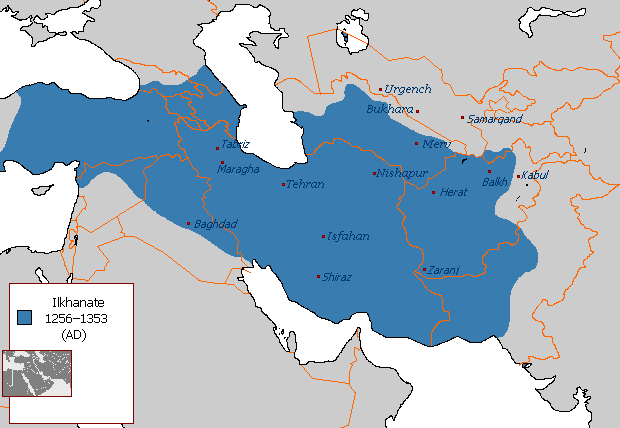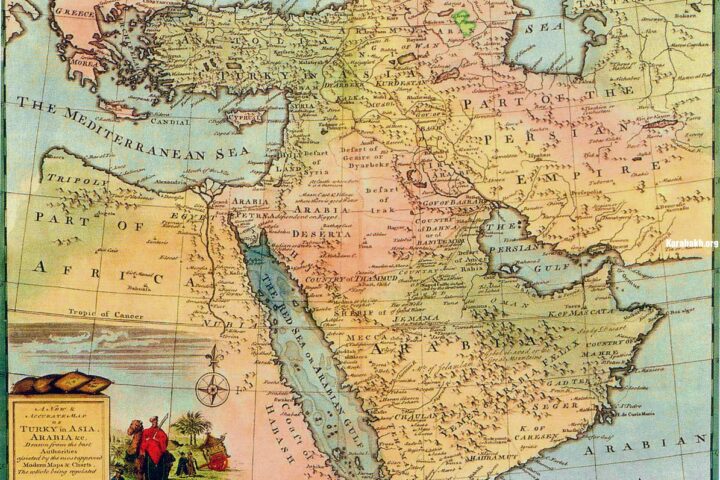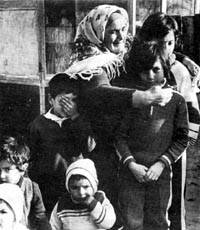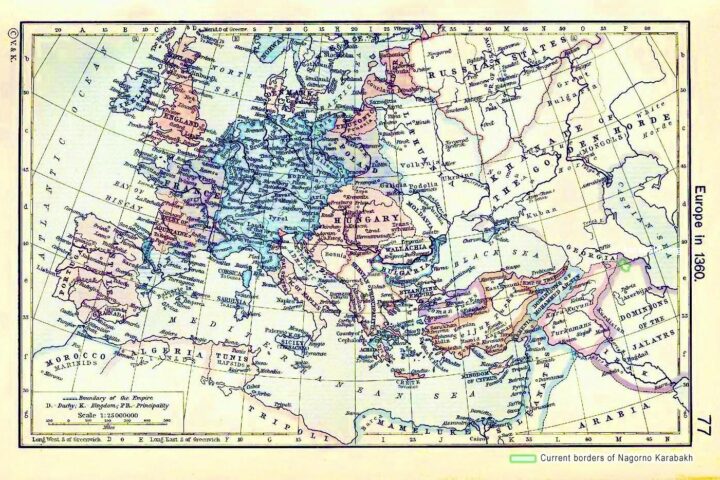In XIII-XIV cc. the major part of the population of Karabakh, which was a part of the Arran province of Azerbaijan, consisted of the Azeri Turks and the offspring of the Christian Albanians.
Beginning from the 20-30s of XIII c. Azerbaijan underwent the Mongol-Tatar invasion. By 1239 they completed the invasion of Azerbaijan and by 1258 Azerbaijan became a part of the Mongolian Empire of Khulagoids. The Khachin principality managed to preserve its autonomy for some time but after Hasan Jalal was killed by order of the Khulagoid prince Argun in 1261, it gradually declined.
In XIII-XIV cc. Karabakh became one of the socio-economic centers in Azerbaijan. Constant wintering of the Mongolian rulers in here resulted in that many important events took place in Karabakh. It is notable, that three Mongolian rulers (Qazan khan, Arpa khan and Anushiravan) came into the power in Karabakh; here also died two other rulers (Argun khan and Abu Said).1
In 1295 an important historical event took place in Karabakh. Qazan khan (1295-1304) came into the power. He radically changed the political orientation of the Khulagoid State and chose the way of rapprochement and bettering of the relations with the local feudal lords. For this purpose, Qazan khan accepted Islam and held tax, military etc. reforms. He also suppressed the plot of other nomad feudal lords dissatisfied with his policy and when doing that relied, mainly, on the local feudal lords and population. All of these assisted strengthening of the positions of the local feudal lords, weakening of the Mongolian yoke and also, acceleration of the assimilation process of the culturally backward, relatively to the local population, Mongolo-Tatar tribes.
According to the administrative division of XIII-XIV cc. Karabakh, as it was during the Arabs’ rule, was a part of Arran. Arran, being a greater administrative-geographic unit of Azerbaijan was included into the Khulagoid State as a province. The Russian oriental historian A. Yakubovsky noted, that in XIII-XIV cc. «Azerbaijan» proper name implied both the territory of present-day Iranian (Southern) Azerbaijan and of the Northern Azerbaijan.2
Let’s apply to the historical sources for better understanding of the borders of the Arranian (Northern) Azerbaijan at that time. Yakut Hamavi (1179-1229) wrote: «Nakhichevan is a town in Azerbaijan, or as some people say in Arran. It borders with Armenia».3 And the town of Dvin (Dabil) the author calls «a town in the Arran province, situated in far western frontiers of Azerbaijan».4 The geographer of that time Hamdullah Kazvini wrote: «The Gekcha Lake [present-day Sevan] is situated on the border of Azerbaijan with Armenia».5 According to the prominent oriental historian V.V. Bartold, an extensive territory from Derbent to the suburbs of Tiflis (in the west) and to the river of Araz was originally called «Arran».6 As an anonymous author of XIII c. wrote in his work «Ajayib-ad-Dunia», Arran had width of approximately 30 farsakhs (200 km), and length 40 farsakhs (270 km), all the left bank of the river of Kura till it joined with Araz was attributed to Arran7 (the left bank of the Kura was known as Shirvan). Khamdullah Kazvini pointed out that Karabakh extended to Araz, which was its [southern] border.8 According to the medieval Azeri historian Abubakr Al-Kubi (XIV c.), Karabakh was considered the center of Arran. The term «Karabakh» also was utilized equally with «Arran», sometimes replacing the latter, but in administrative-territorial respect, Karabakh covered a part of Arran and was situated in the territory with mountainous and foothill relief.
As to the ethnic composition of the Karabakh population in XIII-XIV cc., it has to be mentioned again, that the territory of the whole Caucasus, including Karabakh, was one of the regions, where complex ethnic processes took place, formed new ethnic groups and melted in the history the old ones. Also, as already mentioned, before the Mongolian invasion of Azerbaijan, its population, including a part of the Karabakh population had formed as a Turkophone ethnicity. It becomes clear from the information given by the author of «Ajayib-ad-Dunia» (XIII c.), that Turks were the major ethnic group in Arran, as well as in the whole Azerbaijan. Here, as the historian noted, were more than 100.000 Turk horsemen.9 In Arran, wrote Shihabaddin Muhammed an-Nasavi (XIV c.), «there are so many Turkomans, that if they gather together, then they would be like an accumulation of ants or clouds of locusts».10
As known from history, in mid XIII c. during Hulagu khan’s invasion, along with Mongolian tribes, some Turkophone tribes also came to Azerbaijan. Consequently, having settled down, most part of them has mixed with the local population. The territory of Karabakh didn’t stay out of this process either. Favorable natural conditions of Karabakh, its climate, as well as that this region was a place for wintering of the Mongol-Tatar feudal lords, have assisted to arrival of many tribes in here.
Settlement of the Turkophone tribes in Karabakh have influenced the ethnic processes and assisted further increase of number of the Turkophone population.11
Albanian ethnic group also constituted a part of the Karabakh population. They inhabited mainly the mountainous regions of Karabakh, particularly, in the territory of the Khachen principality. The Armenian author Kirakos Gandzaketsi (XIII c.) mentions Albanians («Aghvanians») as an independent ethnic unit. This author also points out that the territory of Karabakh was not a part of Armenia. Thus, when touching upon the first Mongolian invasion in 1220 Kirakos Gandzaketsi wrote: «…a great number of troops … through the Derbent passage came to Aghvank, to penetrate from there to Armenia and Georgia».12 The names «Albania» («Aghvania» or «Aghvank») and «Albanian» («Aghvanian») were not associated respectively neither with Armenia nor with the Armenians.
Thus, proceeding from the sources of the time, it can be concluded, that in XIII-XIV cc. the main part of the Karabakh population consisted of Azeri Turks and the offspring of the Christian Albanians. The frontiers of Karabakh, situated in mountainous and foothill regions of the central Arran, stretched to the Araz river in the South-East, the Kura – in the North-East, Zegam river – in the North-West, and approximately near the Akera river – in the South-West.
Sources:
- «Karabakh». (not published yet) Red. A. Abbasov, Ph. D. The institute of Archeology and Ethnography of the Academy of Sciences of Azerbaijan. «History of Karabakh» section, chap. III (Karabakh in XIII-XIV cc.) p. 73
- Id. p. 70
- Id.
- Id.
- Id.
- V.V. Bartold, Works (Sochineniya), v. III, Moscow 1965, p. 334
- «Historical geography of Azerbaijan» (Istoricheskaya geografiya Azerbaydzhana) Baku 1987 p. 100 / also: A. A. Alizadeh «Socio-economic and political history of Azerbaijan in XIII-XIV cc.» (Socialno-ekonomicheskaya i politicheskaya istoriya Azerbaydzhana XIII-XIV v.) Baku 1956 p. 51 (in Russian);
- Hamdullah Kazvini «Nuzhat-al-Kulub» cited in «Karabakh». p. 71;
- «Karabakh», chap. III «Karabakh in XIII-XIV cc.», p. 79;
- Id. pp.79-80
- Id. p. 80
- Id. p. 81







